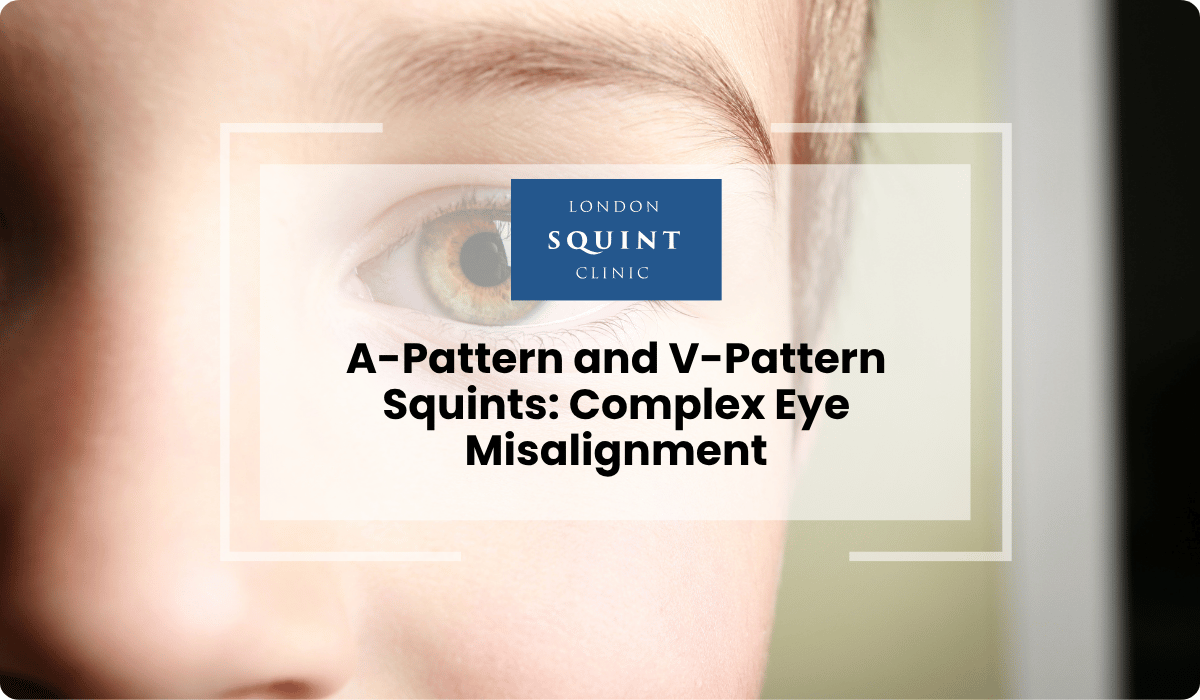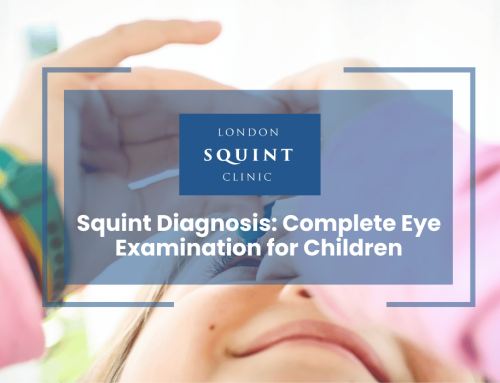A-Pattern and V-Pattern Squints: Complex Eye Misalignment
- A-pattern and V-pattern squints are complex forms of strabismus where eye alignment changes when looking up versus down, resembling the respective letters.
- These patterns are primarily caused by dysfunction of the oblique eye muscles, with overaction or underaction affecting alignment in different gaze positions.
- Signs include changing eye alignment with gaze direction, abnormal head positioning, and difficulties with depth perception or reading.
- Diagnosis requires specialized testing across multiple gaze positions to measure the exact pattern and identify specific muscle dysfunction.
- Treatment options range from non-surgical approaches (glasses, prism therapy) to surgical procedures targeting the oblique muscles.
- With appropriate and timely intervention, 70-80% of children achieve satisfactory alignment, though long-term follow-up is essential throughout childhood.
- Early detection and treatment during critical visual development periods offer the best chance for optimal binocular vision outcomes.
Table of Contents
- Understanding A-Pattern and V-Pattern Squints in Children
- What Causes Alphabet Pattern Strabismus in Kids?
- Recognizing the Signs of A and V Pattern Eye Misalignment
- Diagnostic Approaches for Pattern Squints in Pediatric Patients
- Treatment Options for A-Pattern and V-Pattern Strabismus
- The Role of Oblique Muscle Dysfunction in Alphabet Squints
- Long-Term Outlook for Children with Pattern Strabismus
Understanding A-Pattern and V-Pattern Squints in Children
A-pattern and V-pattern squints represent complex forms of eye misalignment (strabismus) that change depending on the direction of gaze. Unlike standard squints that maintain consistent alignment, these “alphabet” patterns show characteristic variations when children look up versus down.
In A-pattern strabismus, the eyes are more divergent (turned outward) when looking up and less divergent or more convergent (turned inward) when looking down. Visually, the alignment pattern resembles the letter “A” – wider at the top and narrower at the bottom.
Conversely, V-pattern strabismus presents with eyes that are more convergent when looking up and more divergent when looking down. This creates a “V” shape in the alignment pattern – narrower at the top and wider at the bottom.
These pattern deviations significantly impact a child’s binocular vision and depth perception, particularly when transitioning between different gaze positions. Children with alphabet pattern squints may unconsciously adopt head positions to maintain the gaze direction where their eyes are best aligned, often tilting their chin up or down to compensate.
Understanding these complex alignment patterns is crucial for proper diagnosis and management, as they typically require specialised treatment approaches beyond those used for standard horizontal strabismus. Early identification of these patterns helps prevent long-term visual development issues and ensures appropriate intervention during critical developmental periods.
What Causes Alphabet Pattern Strabismus in Kids?
Alphabet pattern strabismus in children stems from several underlying mechanisms, with oblique muscle dysfunction being the most common cause. The eye’s movement is controlled by six extraocular muscles – four rectus muscles and two oblique muscles. When these muscles don’t function in perfect coordination, pattern strabismus can develop.
For A-pattern squints, overaction (hyperfunction) of the superior oblique muscles or underaction (hypofunction) of the inferior oblique muscles is typically responsible. This muscle imbalance causes the eyes to diverge more when looking upward and converge more when looking downward.
V-pattern strabismus often results from the opposite scenario – overaction of the inferior oblique muscles or underaction of the superior oblique muscles. This causes increased convergence on upward gaze and increased divergence on downward gaze.
Other contributing factors may include:
- Anatomical variations in the orbital structure
- Abnormal insertions of the rectus muscles
- Craniofacial abnormalities affecting eye muscle function
- Neurological conditions affecting eye muscle control
- Genetic factors influencing eye muscle development
Children with certain conditions like Down syndrome, Crouzon syndrome, or craniosynostosis have a higher incidence of pattern strabismus due to their distinctive orbital anatomy. Additionally, some children develop these patterns secondary to previous eye muscle surgery or as part of a more complex strabismus presentation.
Understanding the specific cause in each child is essential for developing an effective treatment plan that addresses the underlying muscle dysfunction rather than just the visible misalignment.
Recognizing the Signs of A and V Pattern Eye Misalignment
Identifying A-pattern and V-pattern squints in children requires careful observation of eye alignment across different gaze positions. Parents and healthcare providers should be vigilant for these characteristic signs that distinguish alphabet pattern strabismus from other forms of eye misalignment.
The most notable feature is the change in eye alignment when looking up versus down. In A-pattern squints, the eyes appear more separated (divergent) when the child looks upward and closer together or even crossed (convergent) when looking downward. With V-pattern squints, the opposite occurs – eyes appear more aligned or crossed when looking up and more separated when looking down.
Other common signs include:
- Abnormal head positioning – children may tilt their head up or down to find the position where their eyes work best together
- Complaints of double vision (diplopia) that changes with gaze direction
- Difficulty with reading or close work, which primarily involves downward gaze
- Problems with depth perception and hand-eye coordination
- Visible overaction of certain eye muscles when looking in specific directions
- Squinting or closing one eye when looking in certain directions
Parents might notice that their child’s eye alignment seems inconsistent throughout the day. This variability is characteristic of pattern strabismus, as alignment changes with different visual tasks and gaze positions. For instance, a child with V-pattern strabismus might appear to have well-aligned eyes when reading (downward gaze) but show noticeable divergence when looking at objects on a high shelf.
Early recognition of these signs is crucial for timely referral to a paediatric ophthalmologist who can diagnose and treat the specific type of squint affecting the child’s vision development.
Diagnostic Approaches for Pattern Squints in Pediatric Patients
Diagnosing A-pattern and V-pattern squints requires comprehensive assessment by a paediatric ophthalmologist using specialised techniques to evaluate eye alignment across different gaze positions. The diagnostic process typically involves several key components designed to characterise the pattern precisely.
The primary diagnostic tool is the prism cover test, performed in nine cardinal positions of gaze. This test measures the exact angle of misalignment when the child looks straight ahead, up, down, left, right, and in the four oblique directions. By comparing measurements in upgaze versus downgaze, the ophthalmologist can quantify the A or V pattern.
Additional diagnostic approaches include:
- Versions and ductions testing – assessing how well each eye moves individually and together in all directions
- Oblique muscle function evaluation – specifically testing for overaction or underaction of the superior and inferior oblique muscles
- Fundus examination – sometimes revealing torsional positioning of the retina that suggests oblique muscle dysfunction
- Sensory testing – evaluating binocular vision status and presence of suppression or abnormal retinal correspondence
- Cycloplegic refraction – ruling out accommodative factors that might contribute to the pattern
For younger or less cooperative children, video recording of eye movements can be particularly helpful in documenting the pattern. Special attention is paid to head positioning, as children often develop compensatory head tilts to optimise their binocular vision.
Neuroimaging studies like MRI may be recommended in certain cases, particularly if there are concerns about neurological causes or if the pattern is highly asymmetric. These comprehensive diagnostic approaches ensure that treatment can be precisely tailored to address the specific pattern and underlying muscle dysfunction in each child.
Treatment Options for A-Pattern and V-Pattern Strabismus
Managing A-pattern and V-pattern strabismus requires a tailored approach based on the specific pattern, underlying muscle dysfunction, and the child’s visual development stage. Treatment aims to improve eye alignment across all gaze positions, enhance binocular vision, and prevent or treat amblyopia (lazy eye).
Non-surgical interventions are typically considered first, particularly for mild patterns:
- Glasses – to correct any refractive errors that may contribute to the misalignment
- Prism therapy – special prisms incorporated into glasses can help compensate for misalignment in certain gaze positions
- Orthoptic exercises – vision therapy to improve binocular coordination and fusion
- Patching therapy – for associated amblyopia, though this addresses visual acuity rather than the pattern itself
For moderate to severe pattern strabismus, surgical intervention is often necessary. Surgery typically targets the oblique muscles and may include:
- Weakening procedures for overacting muscles (such as inferior oblique recession for V-patterns)
- Strengthening procedures for underacting muscles
- Horizontal muscle surgery with vertical transposition – shifting the insertion points of the medial or lateral rectus muscles to address the pattern
- Adjustable suture techniques – allowing fine-tuning of alignment post-operatively
The surgical approach is highly individualised based on measurements of the pattern magnitude, specific muscle dysfunction, and previous treatments. In some cases, a staged surgical approach may be recommended, with the oblique muscle dysfunction addressed first, followed by horizontal muscle surgery if needed.
Post-treatment follow-up is essential to monitor alignment, assess binocular function, and ensure optimal visual development. Some children may require additional interventions or adjustments to their treatment plan as they grow and their visual system continues to develop.
The Role of Oblique Muscle Dysfunction in Alphabet Squints
Oblique muscle dysfunction plays a central role in the development of alphabet pattern strabismus. The eye’s oblique muscles – the superior and inferior obliques – have unique actions that significantly influence vertical and torsional eye movements, particularly in different gaze positions.
The superior oblique muscle, when functioning normally, primarily intorts the eye (rotates the top of the eye toward the nose) and helps move the eye downward, especially in adducted positions (when the eye looks inward). When this muscle overacts, it creates excessive downward pull in adduction, contributing to A-pattern strabismus. Conversely, underaction of this muscle can contribute to V-pattern strabismus.
The inferior oblique muscle normally extorts the eye (rotates the top of the eye away from the nose) and assists with upward movement, particularly in adducted positions. Overaction of the inferior oblique is a common cause of V-pattern strabismus, while underaction can contribute to A-patterns.
Several factors can lead to oblique muscle dysfunction:
- Congenital anatomical variations in muscle insertion or structure
- Neurological factors affecting muscle innervation
- Mechanical restrictions from orbital abnormalities
- Adaptive changes secondary to other forms of strabismus
- Compensatory overaction developing after previous eye muscle surgery
Clinical examination often reveals characteristic signs of oblique dysfunction, such as elevation or depression of the adducted eye, fundus torsion, and specific changes in alignment with head tilting (Bielschowsky head tilt test). Understanding the precise nature of the oblique dysfunction is crucial for surgical planning, as different procedures target specific aspects of muscle function.
In children with craniofacial abnormalities, the relationship between orbital anatomy and oblique muscle function becomes even more complex, often requiring specialised imaging and surgical approaches to address both the pattern strabismus and underlying anatomical factors.
Long-Term Outlook for Children with Pattern Strabismus
The long-term prognosis for children with A-pattern and V-pattern strabismus depends on several factors, including the severity of the pattern, timing of intervention, underlying causes, and response to treatment. With appropriate management, many children achieve significant improvement in eye alignment and binocular function.
For children who undergo surgical correction, success rates are generally favourable, with approximately 70-80% achieving satisfactory alignment across different gaze positions after appropriate intervention. However, some degree of pattern may persist, particularly in complex cases or those associated with craniofacial abnormalities.
Several factors influence long-term outcomes:
- Age at intervention – earlier treatment during critical periods of visual development typically yields better functional results
- Presence of amblyopia – children with associated lazy eye may have more limited binocular potential even after alignment correction
- Pattern severity – larger patterns may require more extensive surgery and have higher rates of undercorrection or recurrence
- Associated conditions – children with neurological or developmental disorders may have more complex courses
- Compliance with non-surgical treatments – consistent use of glasses or completion of orthoptic exercises when prescribed
Long-term follow-up is essential, as some children experience changes in their pattern over time, particularly during growth spurts or after significant changes in refractive error. Additionally, some may develop secondary adaptive changes that require further intervention.
From a functional perspective, successful management of pattern strabismus can significantly improve a child’s visual comfort, reading efficiency, depth perception, and overall visual quality of life. Many children who receive timely and appropriate treatment go on to develop normal or near-normal binocular function, allowing them to participate fully in educational, social, and athletic activities without visual limitations.
Parents should maintain regular ophthalmological follow-up throughout childhood and adolescence to monitor alignment, assess binocular function, and address any changes promptly to ensure optimal long-term visual outcomes.
Frequently Asked Questions
What is the difference between A-pattern and V-pattern strabismus?
A-pattern strabismus shows eyes that are more divergent (turned outward) when looking up and more convergent (turned inward) when looking down, resembling the letter “A.” V-pattern strabismus presents the opposite: eyes are more convergent when looking up and more divergent when looking down, forming a “V” shape. These patterns are defined by how eye alignment changes between upward and downward gaze positions.
At what age can alphabet pattern squints be diagnosed in children?
Alphabet pattern squints can be diagnosed as early as 6-12 months of age, though they often become more apparent between ages 2-4 years when children’s visual systems mature and cooperation with testing improves. Early diagnosis is possible through specialized pediatric ophthalmological examinations that assess eye alignment in different gaze positions.
Can A and V pattern strabismus resolve without treatment?
A and V pattern strabismus rarely resolves without treatment. Unlike some forms of infantile strabismus that may improve spontaneously, pattern strabismus typically persists or worsens without intervention because it’s usually caused by structural muscle dysfunction. Early treatment is recommended to prevent amblyopia and promote normal binocular vision development.
How successful is surgery for pattern strabismus in children?
Surgery for pattern strabismus is successful in approximately 70-80% of cases, with most children achieving satisfactory alignment across different gaze positions. Success rates depend on pattern severity, underlying muscle dysfunction, timing of intervention, and presence of associated conditions. Some children may require additional procedures to fully correct complex patterns.
Will my child need glasses after treatment for A or V pattern squint?
Many children with pattern strabismus will need to continue wearing glasses after surgical treatment. Glasses serve multiple purposes: correcting refractive errors, maintaining alignment, and supporting binocular vision. The need for glasses may change over time as the child grows, and some children may eventually reduce their dependence on glasses, particularly if the pattern correction is stable.
How does pattern strabismus affect a child’s reading and school performance?
Pattern strabismus can significantly impact reading and school performance because reading primarily involves downward gaze, where alignment changes are most noticeable. Children may experience double vision, eye strain, difficulty tracking across lines of text, or poor depth perception. They might adopt abnormal head positions or avoid reading altogether, potentially affecting academic achievement. Proper treatment typically improves these functional difficulties.
Can children with A or V pattern strabismus develop normal depth perception?
Children with early diagnosis and appropriate treatment for A or V pattern strabismus can develop functional depth perception, especially if treatment occurs during the critical period of visual development (before age 8-10). However, the level of stereopsis (3D vision) achieved depends on alignment quality, timing of intervention, and whether amblyopia was present. Some children achieve near-normal depth perception, while others develop functional but reduced stereoscopic vision.
Find out if you are suitable for Double Vision Treatment
Not everyone is eligible for double vision surgery.
Find out if you could benefit from this life-changing surgery by taking the quick self-suitability quiz below:
Our most popular procedures

Hello, I’m Nadeem Ali
I’m one of the few eye surgeons in the world with 100% focus on Squint and Double Vision Surgery.
I have 24 years of eye surgery experience, and worked for 13 years as a Consultant at London’s renowned Moorfields Eye Hospital.
In 2023, I left the NHS to focus fully on treating patients from across the world at the London Squint Clinic. You can read more about me here.
There’s lots of information on the website about: squint surgery, double vision surgery and our pricing.
The most rewarding part of my job is hearing patients tell me how squint or double vision surgery has changed their lives. You can hear these stories here.
Mr Nadeem Ali
MA MB BChir MRCOphth FRCSEd(Ophth)





